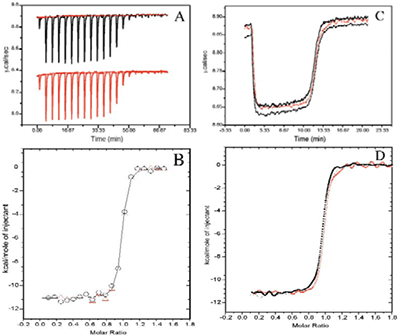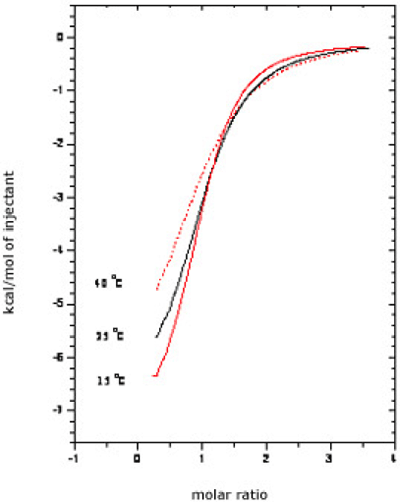The Single Injection Method (SIM) is an innovative ITC technique for use with the MicroCal VP-ITC system.
The Single Injection Method (SIM) is an innovative ITC technique for use with the MicroCal VP-ITC system. SIM provides versatility and speed for many applications characterizing the molecular interactions of biomolecules.
Traditional ITC with discrete titrations has provided accurate and valuable mechanism insights into molecules that bind to one another. However, some pursuits in drug discovery and target screening require more speed than traditional ITC can currently offer. The SIM technique takes an important step forward in providing higher throughput for the applications that could not consider traditional ITC in an assay scheme. With faster stirring speed capability and the highest precision possible for a single continuous injection of ligand, the overall flexibility of ITC using SIM is much improved.

|
| Injection
Method | Temperature
(°C) | Number of
experiments | Experiment Time
(min)a | Stoichiometry
(n) | KD (M) b | ∆H
(kcal mol-1) |
|---|---|---|---|---|---|---|
| Multiple | 15 °C | 3 | 115 | 0.97 ± 0.02 | (13.6 ± 1.4) x 10-9 | -11.1 ± 0.1 |
| SIM | 15 °C | 4 | 65 | 0.98 ± 0.01 | (11.7 ± 0.3) x 10-9 | -11.3 ± 0.2 |
| Multiple | 35 °C | 3 | 115 | 0.96 ± 0.02 | (30.0 ± 6.4) x 10-9 | -13.1 ± 0.5 |
| SIM | 35 °C | 4 | 65 | 0.96 ± 0.03 | (44.9 ± 1.8) x 10-9 | -11.6 ± 0.4 |
The SIM technique for ITC is optimized for use with binding models exhibiting a linear relationship (e.g. 1:1; 2:2). Capable of being run at a wide range of temperatures (15ºC to 40ºC) and with binding partners exhibiting affinities from 103 to 109 M-1 , the SIM can provide additional versatility.
Examples in the above table demonstrate a significant savings in titration time using SIM. Intelligent experimental design with equivalent equilibration times, comparable wash/rinse cycles and cell/syringe fill times has the potential of resulting in up to a 2-2.5 times increase in throughput over standard multiple injection ITC runs.

|
| Injection
Method | Temperature
(°C) | Number of
experiments | Experiment
Time (min)a | Stoichiometry
(n) | KD (M) b | ∆H
(kcal mol-1) |
|---|---|---|---|---|---|---|
| Multiple | 15°C | 1 | 153.5 | 1.07 | 11.07 x 10-5 | -7.63 |
| SIM | 15°C | 2 | 65 | 1.02 ± 0.01 | (12.56 ± 0.95) x 10-5 | -7.69 ± 0.1 |
| Multiple | 25°C | 1 | 153.5 | 1.01 | 17.76 x 10-5 | -7.15 |
| SIM | 25°C | 2 | 65 | 1.04 ± 0.01 | (18.51 ± 0.72) x 10-5 | -7.38 ± 0.01 |
| Multiple | 40°C | 2 | 153.5 | 0.94 ± 0.03 | (31.67 ± 2.0) x 10-5 | -7.03 ± 0.26 |
| SIM | 40°C | 2 | 65 | 1.02 ± 0.01 | (28.68 ± 0.82) x 10-5 | -6.69 ± 0.22 |
Experiments and data analysis performed as described in the figure legend above.
aExperiment time includes 45 min experimental set-up (cell/syringe washing, cell/syringe filling, and final cell equilibration) and titration time.
b Reported as K (M-1) in the software
The precision of the SIM measurements is sample dependent. The determinations shown in the table above made on identical samples are comparable for SIM and multiple injection methods. More demanding samples may result in a slightly higher error rate in the binding constant due to unpredictable influences such as noisy baselines. For applications requiring maximum precision, the multiple injection ITC method will continue to be the gold standard for measuring molecular interactions. For screening applications or initial exploratory binding characterization experiments, SIM will provide additional versatility and speed.
Hardware and software upgrades may be required to use SIM on your system. For older MicroCal VP-ITCs, this is the perfect way to tune-up your trusted calorimetry work horse. For newer Microcal VP-ITCs only a software upgrade may be required. Contact your local Malvern office for upgrade details.